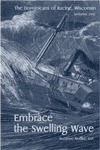In the year 1858 I was released from the duties of my office. Immediately the long cherished desire of laboring in the missions again took hold of my soul. With the permission of the reverend bishop and of the mother prioress, I was soon ready to pursue my former plan to found a mother monastery of our holy order in America and to propagate the order if God so willed…. Three of us sisters, then, began our journey, arriving in America on the twenty-second of October, 1858. For a time we remained at Williamsburg — until they could spare us. After twenty months I, with Sister Thomasina, a most pious and worthy fellow sister went to the reverend father provincial with the purpose of seeking his advice in regard to the founding of a mother monastery…. The beginning was to be made at Nashville, Tennessee, where the Most Reverend J. Whelan, OP, bishop of Nashville, wanted German Dominican sisters for a German parish in his diocese. We traveled to Nashville in his company and stayed there with the sisters of the Third Order for six months. During this time the hot climate so affected my health that a longer stay would surely have caused my death. Our plan for building a monastery was abandoned, and we directed our steps to the north. We traveled to the state of Wisconsin where we were received most cordially by the most reverend bishop, John Martin Henni, and adopted into his diocese. How lovingly divine providence had provided! Scarcely had we left Nashville when the unfortunate war began, and Nashville became a center of fighting from the beginning to this very day. How fortunate it was that we escaped this great danger! Thanks be to God!
With paternal affection the bishop pointed out several places for a foundation. We chose Racine, which is near Milwaukee, the see of the bishop. We purchased a property on which there was a large house. This plot is a very suitable place for a motherhouse. It is outside of the city in a healthful location. For the time being the house has been dedicated as our little monastery in honor of Saint Catherine of Siena, and the chapel has been dedicated to our holy father Dominic. Thus the foundation of a motherhouse has been made on a modest scale. Our personnel consists of seven professed sisters, five novices, and six candidates. We have, besides, twelve girls in our home, and were it not for lack of room, we would have a larger number of pupils. We have children of various creeds who feel drawn to our holy faith. Lately, one of these was baptized.
Our occupation is to instruct children in two schools and to plant saplings for the garden of Saint Dominic. Oh, how much good can be effected in this country where many children are reared without religion or Christian training! Children aged fifteen do not know how to make the sign of the cross. Material assistance is scant, but we may boast of the holy poverty which our holy father has left us as an inheritance. Still, we always have our present needs supplied, and we have peace in our home, which is worth more than all the goods of this world. The blessing of God is truly with us. We can fulfill the holy rule here substantially. We pray in choir and alternate sides in saying the breviary. We have daily meditation and spiritual reading; we have holy confession weekly, holy communion twice a week; we have spiritual conferences, and, in fact, all the means for sanctification. Earlier, because we were in need of a resident priest, we had to go to a parish church a little distance away; we hope soon to obtain the services of a permanent priest, and then we can keep the enclosure conscientiously…. It is certainly harder to establish a monastery in America than in Europe, but the merit is richer and the poverty greater…

Embrace the Swelling Wave by Suzanne Noffke, OP
The first volume of the history of the Racine Dominicans, Embrace the Swelling Wave, by Suzanne Noffke, O.P., received the Wisconsin Historical Society's 2005 Award of Merit for its contribution to the history of the state.
Read brochure describing the book.
Order Embrace the Swelling Wave from the publisher, Authorhouse.


.jpg)